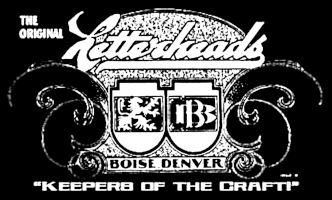Posted by Mike Jackson on November 10, 2003

Here's the front cover of one of Rawson & Evans catalogs...or was it a sales tool? This one was part of an 8 page booklet. I also added a page showing two of a 21 page booklet.
You can see them by clicking on the links shown on the Rawson and Evans Main Page.
http://www.theletterheads.com/lhparts/rawsonevans.html
Thanks a bunch to Danny Baronian who generously shared from his archives.
Mike Jackson
Mike Jackson - Sani-Onyx Signs
Mike Jackson Sani-Onyx Signs More InfoI noticed the category in the Rawson and Evans 8 pager that described Sani-Onyx Signs. The note said they had developed the process in 1913, so we know the catalog is later than that date.
I asked Danny to type out exactly what the catalog says about Sani-Onyx Signs and he took the time to send it back:
"SaniOnyx Electric signs embrace all of the superior features of our Art Glass Electric Signs, excepting the opalescent colorings. They are artistically designed, far-reading, economical to operate. Inexpensive in price and very effective signs for both night and day use.
Sani-Onyx Electric signs are made of a translucent, snow-white, glass-like substance of the same general character as used in our Sani-Onyx non-illuminating signs, illustrated and described on page 5 of this catalogue, only that it is not so heavy and is translucent.
The signs are made either with translucent white letters on a colored opaque background or with colored opaque letters on a translucent white background, as preferred. They are also frequently furnished in a combination of both styles of work, as illustrated by design E2894 (Buck & Rayner Drugs at the bottom).
The colored letters or background as may be the case, are etched deeply into the face of the glass like material by a sand-blasting process after which this sunken surface is treated to several applications of colored enamel. The colors used are unusually dark green, maroon or black, although we can finish the signs in practically any desired colors.
Sani-onyx Electric Signs are constructed, mounted and equipped identically the same as our Art Glass Signs with the exception that Sani-Onyx Plates are substituted for the Art Glass sides."
In paragraph two, it says the background is a "glass like substance". Interesting!
Mike Jackson
Robare M. NovouI snooped around and found this information:
"In 1900, the Marietta Manufacturing Company claimed to be the first producer of pigmented structural glass, rolling the first sheet of a "substitute for marble," Sani Onyx. PennAmerican Plate Glass Company quickly joined its ranks, manufacturing white and black Carrara Glass around 1906. "
Rawson and Evans' catalog mentions they started using Sani-Onyx for signs in 1913. Based on the descrition in the yellow catalog, they sandblasted into the material and then painted black, dark green, or dark blue in the blasted areas, letting light shine through. They used a more opaque sani-onyx when not inteneded to be back lit. It's not clear initially whether the textured area was facing IN or OUT, but it almost has to be in. If so, this would basically be a sandblasted "dimensional" sign done in a composite material and not in redwood. The booklet does not say how thick the material was, nor how deep they were able to blast.
Tile History Site
http://www.historichomeworks.com/hhw/pbriefs/pb12.htm
Mike Jackson
Mike JacksonMike, When I was at Jeff Langs shop a few months back...he had just acquired a rawson and evans wooden case of individual glass letters for an R&E changeable sign. Rick Glawson also had a box of letters like this,(I wonder where it is now?)Jeff only has the case of letters and not the sign. Although on the inside cover of the box was a picture of the sign and an explaintion of how to use it with the letters, and NO, the letters were not glue chipped and gilded. I would compare these letters on glass to todays letters on plastic for changable copy signs. Except R&E's have a thin lead foil covering on the back that lines up perfectly with the black that is between the lead and the clear glass, I see no cut marks, so this must have been stamped out and then adhered to the glass....anyway...some of the glass pieces were white, and you slid these white pieces behind the lettered clear glass so that only a white letter would show...and then with the help of electricity and light bulbs, it lit up.
This white glass is opaque until you hold it up to the light...then its translucent. Just like plexiglass. It also has the look of carrara glass.
Its about 1/8" thick, and smooth on both sides.
Ive heard stained glass people call this "milk glass".
From looking at the picture of the sign, it possible to remake one and give these letters a new home, Cant wait!!
Jeff has told me he sent you a pic or two, looking forward to you posting it.
RMN

Mike Jackson Rawson and Evans Changeable LettersRobare, that case and example is already on the Rawson main page....check it out! I added it at about noon today.
Mike Jackson
http://www.theletterheads.com/lhparts/r ... eable.html
Robare M. Novou
Great Post Mike!
And Jeff makes a good point about the lead blocking out the light, now I know why its there.
RMN
 Denver Chapter of the Letterheads
Denver Chapter of the Letterheads